Potrebujeme váš súhlas na využitie jednotlivých dát, aby sa vám okrem iného mohli ukazovať informácie týkajúce sa vašich záujmov. Súhlas udelíte kliknutím na tlačidlo „OK“.
ASTM D4966-12e1
Standard Test Method for Abrasion Resistance of Textile Fabrics (Martindale Abrasion Tester Method) (Includes all amendments And changes 8/2/2016).
Automaticky preložený názov:
Štandardná skúšobná metóda pre odolnosť proti oderu z textílií (Martindale oderu Tester Method)
NORMA vydaná dňa 1.2.2012
Informácie o norme:
Označenie normy: ASTM D4966-12e1
Poznámka: NEPLATNÁ
Dátum vydania normy: 1.2.2012
Kód tovaru: NS-29320
Počet strán: 4
Približná hmotnosť: 12 g (0.03 libier)
Krajina: Americká technická norma
Kategória: Technické normy ASTM
Kategórie - podobné normy:
Anotácia textu normy ASTM D4966-12e1 :
Keywords:
abrasion, knit fabric, woven fabric, ICS Number Code 59.080.30 (Textile fabrics)
Doplňujúce informácie
| Significance and Use | ||||||||||||||||||||
|
Acceptance Testing—this test method is not considered satisfactory for acceptance testing of commercial shipments of fabric. The between-laboratory precision of this test method is poor and, because of the nature of abrasion testing itself, technicians frequently fail to obtain results in agreement on the same type of testing instrument, both within and between laboratories. Although this test method is not recommended for acceptance testing, it is useful because it is used widely, especially outside the United States. In case of a dispute arising from differences in reported test results when using this test method for acceptance testing of commercial shipments, the purchaser and the supplier should conduct comparative tests to determine if there is a statistical bias between their laboratories. Competent statistical assistance is recommended for the investigation of bias. As a minimum, the two parties should take a group of test specimens that are as homogeneous as possible and that are from a lot of material of the type in question. The test specimens then should be assigned randomly in equal numbers to each laboratory for testing. The average results from the two laboratories should be compared using Students t-test for unpaired data and an acceptable probability level chosen by the two parties before the testing is begun. If a bias is found, either its cause must be found and corrected or the purchaser and the supplier must agree to interpret future test results in light of the known bias. The resistance to abrasion also is affected greatly by the conditions of the tests, such as the nature of abradant; variable action of the abradant over the area of specimen abraded, the tension on the specimen, the pressure between the specimen and abradant, and the dimensional changes in the specimen. Abrasion tests are all subject to variation due to changes in the abradant during specific tests. The abradant must be changed accordingly at frequent intervals or checked periodically against a standard. With disposable abradants, the abradant is used only once or changed after limited use. With permanent abradants that use hardened metal or equivalent surfaces, it is assumed that the abradant will not change appreciably in a specific series of tests, but obviously similar abradants used in different laboratories will not likely change at the same rate due to differences in usage. Permanent abradants also may change due to pick up of finishing or other material from test fabrics and must accordingly be cleaned at frequent intervals. The measurement of the relative amount of abrasion also may be affected by the method of evaluation and may be influenced by the judgment of the operator. The resistance of textile materials to abrasion as measured on a testing machine in the laboratory is generally only one of several factors contributing to wear performance or durability as experienced in the actual use of the material. While “abrasion resistance” (often stated in terms of the number of cycles on a specified machine, using a specified technique to produce a specified degree or amount of abrasion) and “durability” (defined as the ability to withstand deterioration or wearing out in use, including the effects of abrasion) frequently are related, the relationship varies with different end uses, and different factors may be necessary in any calculation of predicted durability from specific abrasion data. Laboratory tests may be reliable as an indication of relative end-use performance in cases where the difference in abrasion resistance of various materials is large, but they should not be relied upon where differences in laboratory test findings are small. In general, they should not be relied upon for prediction of actual wear-life in specific-end uses unless there are data showing the specific relationship between laboratory abrasion tests and actual wear in the intended end-use. These general observations apply to all types of fabrics, including woven, nonwoven, and knit apparel fabrics, household fabrics, industrial fabrics, and floor coverings. It is not surprising, therefore, to find that there are many different types of abrasion testing machines, abradants, testing conditions, testing procedures, methods of evaluation of abrasion resistance, and interpretation of results. All the test methods and instruments so far developed for abrasion resistance may show a high degree of variability in results obtained by different operators and in different laboratories; however, they represent the methods now most widely in use. Since there is a definite need for measuring the relative resistance to abrasion, standardized test methods are desirable and useful and may clarify the problem and lessen the confusion. |
||||||||||||||||||||
| 1. Scope | ||||||||||||||||||||
|
1.1 This test method covers the determination of the abrasion resistance of textile fabrics using the Martindale abrasion tester. Fabrics of all types may be tested by this method but difficulties may arise with fabrics with a pile depth greater than 0.08 in. (2 mm). 1.2 The values stated in inch-pound units are to be regarded as standard. The values given in parentheses are mathematical conversions to SI units that are provided for information only and are not considered standard. 1.3 This standard does not purport to address all of the safety concerns, if any, associated with its use. It is the responsibility of the user of this standard to establish appropriate safety and health practices and determine the applicability of regulatory limitations prior to use. Note 1—For other current test methods of testing the abrasion resistance of textiles refer to Test Methods D3884, D3885, D3886, D4157, D4158, and AATCC Test Method 93. |
||||||||||||||||||||
| 2. Referenced Documents | ||||||||||||||||||||
|
Podobné normy:
Historická
1.7.2012
Historická
1.10.2013
Historická
1.7.2014
Historická
1.7.2013
Historická
1.7.2012
Historická
1.1.2013


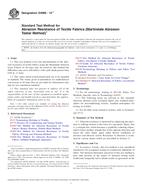
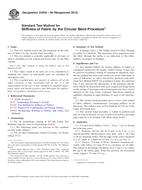 ASTM D4032-08(2012)..
ASTM D4032-08(2012)..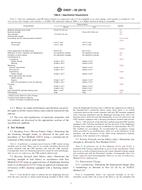 ASTM D4037-02(2013)..
ASTM D4037-02(2013)..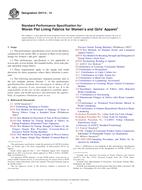 ASTM D4114-14
ASTM D4114-14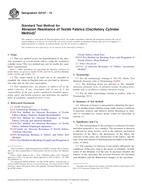 ASTM D4157-13
ASTM D4157-13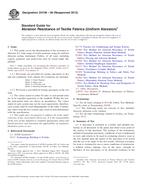 ASTM D4158-08(2012)..
ASTM D4158-08(2012).. ASTM D4391-93a(2013)..
ASTM D4391-93a(2013)..
 Cookies
Cookies
